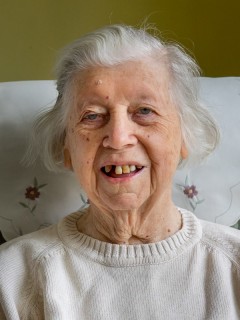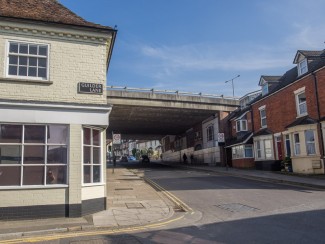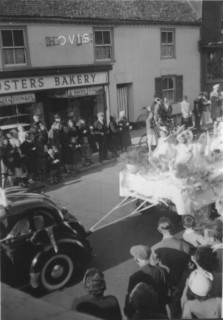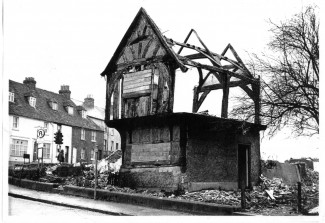6. Milford Street

A Medieval Industry
Look up Milford Street towards the Bridge. Just beyond it you can see Rampart Road. This was the line of the mediaeval rampart. When the bridge was being built, a ‘rescue’ dig was carried out by local archaeologists to trace anything left of the 14th century bell foundry. It was known to have been owned by John Barbur who was from this area and also one of England’s most successful bell founders. Some of his bells can be found today still giving good service in English churches. The archaeologists found furnace remains and his ‘puddling’ pit, in which clay was stirred to make it smooth and free of bubbles. This was used for the casting of the bells. The remains of the stirring devices were also found.
Small Shops – Local Tradespeople – Sadly Missed
On this corner you can see the former premises of Foster’s bakery but it looks very different now – still spoken of fondly by our local people and depicted on the Mural at the next Stand. Fosters was the hub of the community and sellers of the best jam puffs in town!
Barbara Blandford remembers working here. Listen to the audio clip at the right of the page or on your downloaded MP3 file from the Downloads page.
Our interviewees remembered frequenting the many different small shops in this area. The local shops did a thriving business as people shopped locally. It was a time when there were no fridges; so continual ‘top-up’ shopping was needed.
These small shops offered a vital and usually a quality service. The bakeries particularly were remembered as being astonishingly good and are sadly missed.
The Coming Of The Automobile
We noted, in Guilder Lane, how safe the streets were for children in the 1900s, because of the placid nature of horse-drawn traffic. Sadly, if inevitably, that was about to change. In 1930, a traffic census was held on Milford Street. Motors outnumbered horsed traffic by ten to one. On average, 1,000 motor vehicles used the street daily. Of these, two in every five were privately owned.
On our next stop we shall meet the image of a building which once stood where the bridge is now. This was No. 88 Milford Street, a handsome late mediaeval structure, which remained in use till 1972, as a church hall and club rooms for St Martin’s Church.
[Walk icon] Now walk up to the top of Milford Street until you get to the Milford Street Bridge where you will see our two Murals.





Comments about this page
I have fond memories of No 88 . I was a member of St Martin’s Cubs and we used to meet there. Even as a small boy I realised that there was something special about it.
The needs of modern transport have done tremendous damage to Salisbury overthe years.
We – The Brown family , my father Jock Brown worked at the Brewery and we lived at No 44 Milford Street which was a Gibbs Mew House, there between 1955 and 1961 some very happy memories in that street
We would love to see any photos that you may have!
I have fond memories of Milford Street,my Grandfather was Michael Stefano,and had the banana rooms at 43.Spent a lot of my childhood there.There was if i remember right an undertakers next door,and issac beer aswell as the Crystal Fountain.Great memories
Add a comment about this page